Items
Tag is exactly
New York City
-
2020-12-20
Declaring Patient 100 Deceased Life as a NYC EMT During an Unprecedented Global Pandemic
December 20th, 2020, started as an “ordinary” day for myself and my colleagues. 1600 hours rolled around, and my partner and I clocked in for our sixteen-hour tour. We had finally adjusted to our new routine of working a mandatory sixteen hours as opposed to twelve. As emergency medical technicians, we were at the forefront of the COVID-19 Pandemic in New York City. Our region was hit hard by COVID-19 and seemed to be the epicenter of the pandemic for longer than one could ever imagine. For NYC EMS workers before the pandemic, it was common to see around three thousand calls for service daily across all five boroughs. Once the pandemic struck the call volume rapidly overwhelmed the city's EMS resources as they answered a record seven thousand calls for service daily. My partner and I made small talk as we awaited the arrival of the outgoing crew. The day shift arrived back at the station exhausted, defeated, and depressed. They informed us that during their sixteen-hour tour, they had answered twenty calls for service; fifteen of which were for critically ill patients. After some small talk, we exchanged medication kits and radios as it was our turn to serve the great city. Immediately after logging on to the computer system and giving the dispatch center an in-service signal, we were called for a priority one assignment. Our unit was called to the scene of a thirty-two-year-old mother diagnosed with COVID-19 who had stopped breathing. As we arrived at the scene, I donned my four-day-old n95 mask, as well as a makeshift gown made from a garbage bag with holes cut for my head and arms. As we made our way up the five flights of stairs the sound of the screams grew louder. We entered the apartment to find a woman lying on the couch who was clinically deceased. For the next forty-five minutes, my partner and I worked feverishly to perform cardiopulmonary resuscitation, defibrillation, endotracheal intubation, as well as intravenous cardiac drug administration. Despite our efforts, the patient continued to show no signs of life, my partner and I locked eyes and nodded at one another, knowing we had done all that we possibly could have for this patient. I switched the cardiac monitor off and looked down at my watch as I said, “Time of death 1705 hours”. Our next responsibility was to inform the patient’s husband and children of her passing. While you train for many hours to show empathy after death, this task never gets easier. My partner sat in the kitchen with the family, while I prepared the paperwork for a death pronouncement. My partner delivered the life-shattering news and did her best to console a grieving family. After returning to our ambulance to decontaminate our equipment and restock for the next assignment I opened my logbook to record the death encounter. My heart sank as I turned to the next open page which was page number one hundred. In less than one year, I had pronounced one hundred patients deceased from COVID-related illnesses. In my short career before the pandemic, I had only pronounced about fifteen patients deceased. It was at that moment that the true magnitude of the pandemic sank in. COVID-19 had decimated the way of New York City life, the previously bustling city remained shuttered as many remained in indoors in hopes of preventing illness. Before the pandemic, I had known the city as a connection of vibrant neighborhoods filled with culture and joy. COVID-19 had robbed our great city of its life and color; for the next two years, the city appeared black and white as a shell of its previous greatness. These thoughts quickly fled my mind as my unit was once again called to another high-priority assignment. We were called to a sixteen-year-old man diagnosed with asthma, who had recently contracted COVID-19 and was struggling to breathe. Our days were filled with assignments like these, often with no rest, and zero opportunities for a meal break. Nearly one year into the COVID-19 pandemic, my colleagues and I were exhausted, and our mental health and morale were at an all-time low. Many of my collogues fell ill, and four of them died because of COVID-19. We had often asked ourselves and one another; “Why Us? Why are we still doing this job? and when will this end?” While these times were challenging, we understood that we had been called to work in EMS because of our passion for caring for those in need. Day in and day out, we found strength and resilience in one another. My colleagues and I had implemented daily peer support groups in which all were welcome to come and speak about their experiences. While COVID-19 seemed to pull the world apart, it pulled EMS staff closer together. Enemies quickly became friends, and seemingly overnight we all became family. Our perspectives were unique as we were the only healthcare providers to enter the homes of the ill, and feverishly worked to care for them under less-than-ideal conditions. As the number of COVID-19 cases began to decline with the introduction of the vaccine, my colleagues and I felt we could breathe a sigh of relief. As quickly as the pandemic entered our great city, it seemed to vanish even faster. Each shift brought hope as we watched businesses reopen, and the streets were once again filled with color and culture. While we experienced new variants and spikes in COVID-19 cases, we felt that our great city had become stronger and more resilient. While COVID has changed our way of life, one thing I will never forget is the comradery we built amongst the emergency medical services personnel. To this day my colleagues remain a second family in which I can confide after a difficult shift. While COVID was one of the greatest challenges faced by New York City, I feel that it has made us stronger and more resilient than ever. -
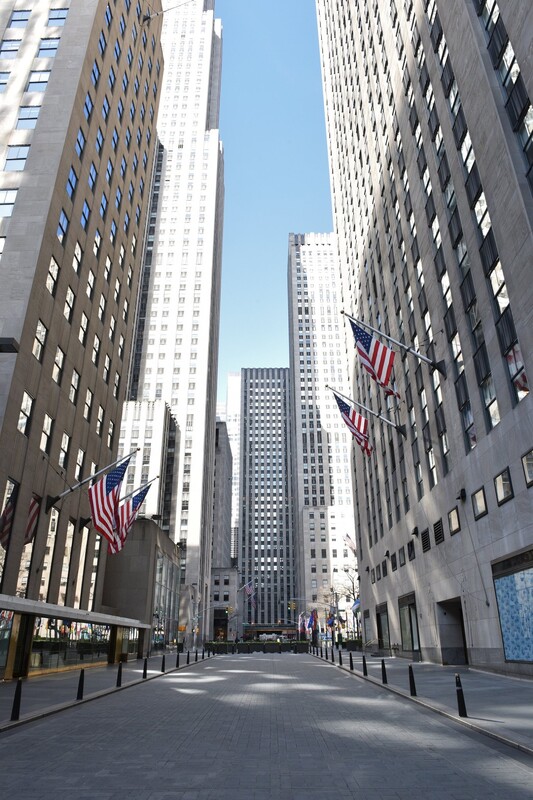 2020-07-27
2020-07-27Empty Rockefeller Center
During the height of Covid, when New York City first went into lockdown, it was surreal to say the least. I think the last time the city was so empty and void of life was 9/11, so to see it again in 2020 really highlighted just how severe the situation was. Two of my sisters, who are a nurse and hospital manager, talked about being in the city for work, and practically being the only ones working in person, and it feeling like some kind of post apocalyptic movie. I remember around May of 2020, I helped my other sister move out of her dorms at #NYU, and it took about 15-20 mins to get to the bottom of Manhattan (Union Square) from The Bronx, due to the lack of fellow cars on the road. To see such a highly populated and lively city such as NYC turn into a ghost town almost overnight was something of a shock. It was one thing to see photos, and speak on how insane the situation was, but to actually be in the heart of Manhattan at this time was… well scary. So, seeing such a busy area such as Rockefeller center be completely empty is insane to say the least, and brings up a sad reminder of just how bad things were in the initial stages of the pandemic. -
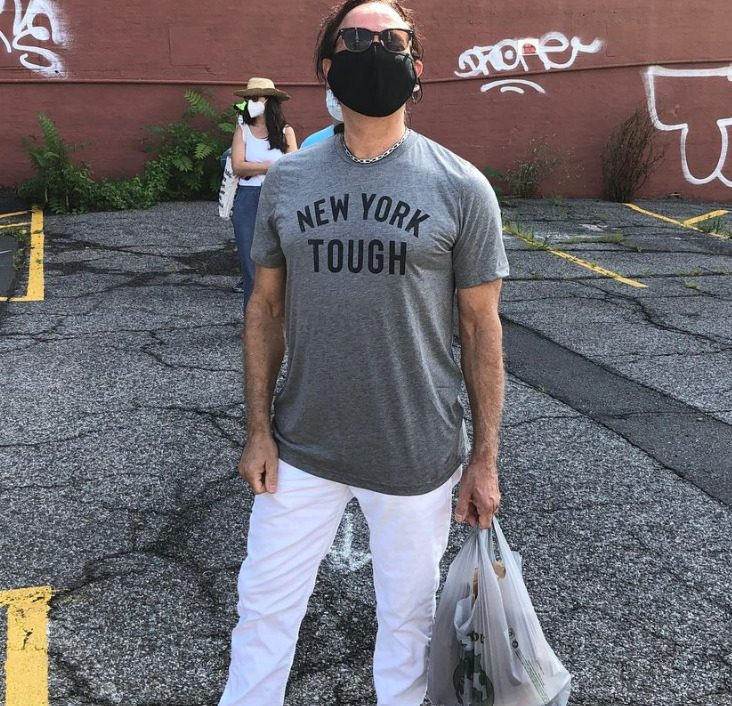 July 26,2020
July 26,2020NYC tough
#newyorktough #nyc #statenisland #greenmarket https://instagr.am/p/CDIBKKxJ3KK/ -
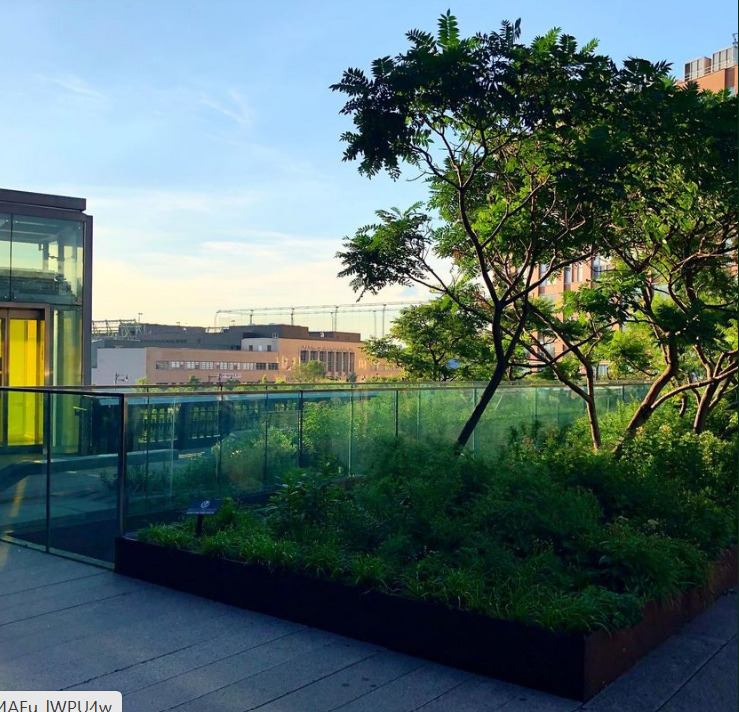 2020-07-21
2020-07-21#twilight on the #highline #nyc #elevator #greenflash
#twilight on the #highline #nyc #elevator #greenflash https://instagr.am/p/CC7EA8ApfcE/ -
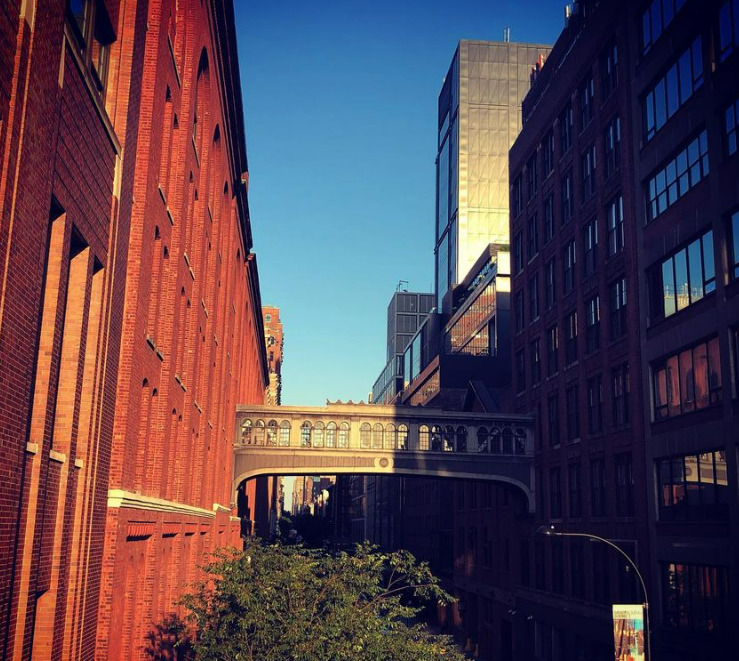 July 21, 2020
July 21, 2020#highline #nyc #goldenhour #bridgeofsighs #bluesky
#highline #nyc #goldenhour #bridgeofsighs #bluesky https://instagr.am/p/CC7EWhrpc-j/ -
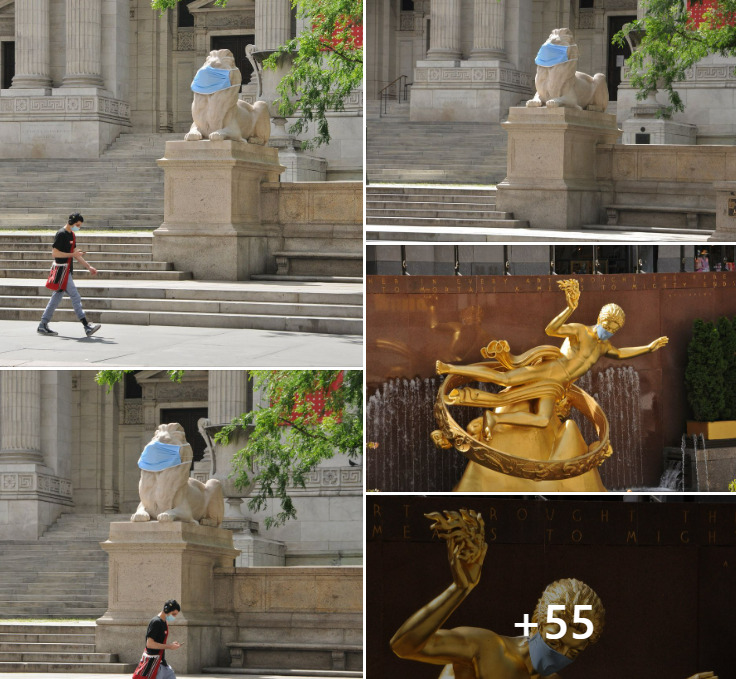 July 27, 2020
July 27, 2020A Covid Summer in NYC
A Covid Summer in NYC -
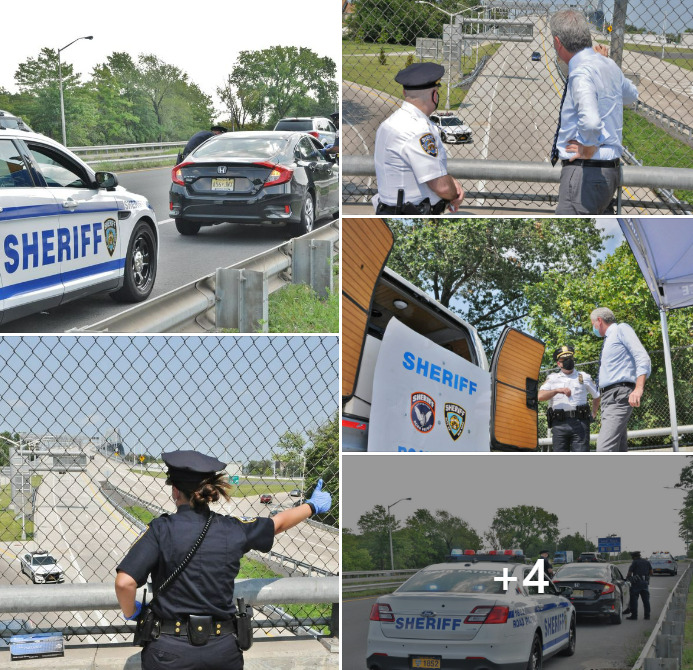 August 30th, 2020
August 30th, 2020Mayor DeBlasio visits Staten Island
Former Mayor Bill DeBlasio visiting Staten Island Branch of the New York City Police Department -
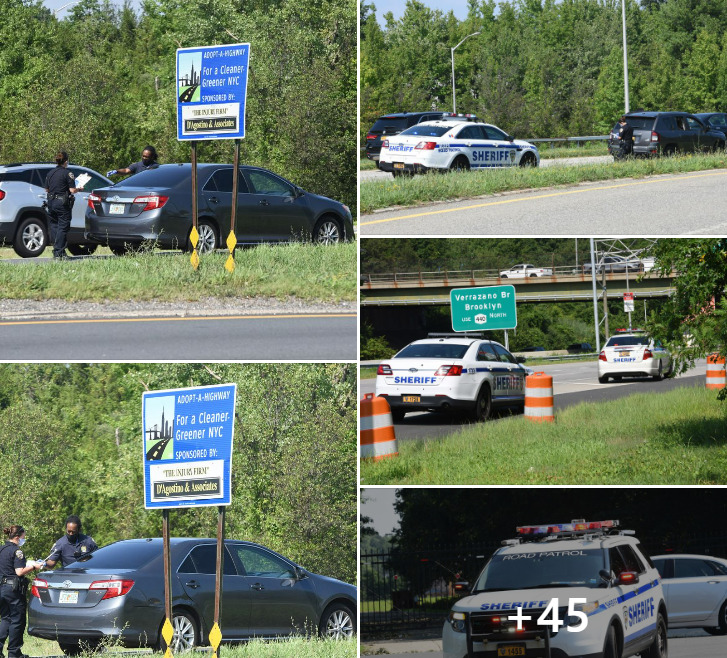 August 24, 2020
August 24, 2020Co-Vid car stops in Staten Island
Co-Vid car stops in Staten Island Sheriff advised me that they have a combination of 10 cars, a mix of TLC and Sheriff cars.They are staging by the entrance of the Outerbridge crossing administration bldg near page Ave. Steve white 8/6/20 -
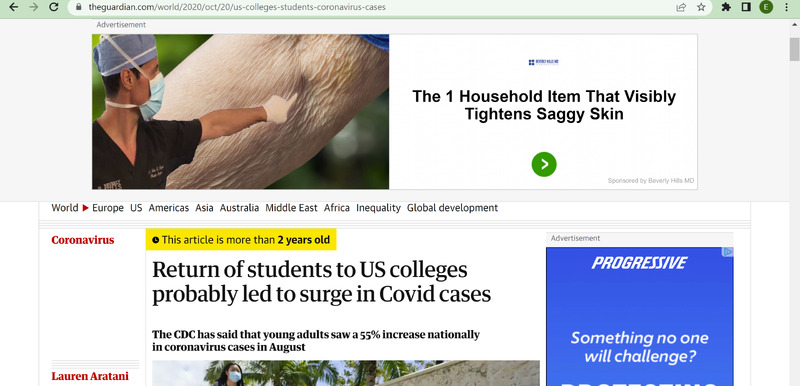 2020-10-20
2020-10-20How covid affected NYC?
Covid has affected everyone by the way you live your everyday life. Covid has affected New york city in many different ways , For example covid affected business to close down months including schools . Schools having to go remote . Another way New york city has been affected by the transit , The transit systems like the trains ,buses and commuter rail and ferries as a result to this the transportation has plummeted . For the subways in New York City it went down 90 percent and the buses went down 75 percent. The reason for this happening is people in quarantine and not going to work since some are working from home . Covid has affected health care workers. For example health care workers like doctors and nurses are around people who have it so they are more prone to get it. .This pandemic caused a lot of changes in the world. It caused everyone to be less social and not go out as much as it caused us to wear masks everywhere. It also caused a lot of people mental and emotional health to go down. For example there’s been a lot of social isolation which caused families to not be able to see each other as often. COVID-19 has impacted social mobility on child care cost and for families school dropout rate has increased due to fear of getting Covid. COVID-19 especially affected families due to not having jobs or working from home or being put on unemployment there’s been a big impact of Covid on families and family relationships creating a lot of tension and feeling depressed or not being united together. These pandemic parts of the population in different situations continue to affect people living in poverty situations with older people and disabilities. A lot of people have been put on unemployment and not being able to pay the rent. Covid has caused a lot of deaths and people could not be able to bury their loved ones. During The beginning of the year when the Pandemic was occurring depending on the situation of others some people were probably affected mentally Health care was provided to those who really needed it due to people not being able to pay for it and The state of new york lost money as well , It affected relationships and people got help by going therapy and staying connected to people . This pandemic affected many people personally. Covid has affected everyone's plan including travel because there's been travel bans and going to the airport has a lot of restrictions. A Lot of businesses are closing down to this pandemic by not giving income . Due to health care a lot of pregnant women had very high dress levels that affected their pregnancy . Which caused health care workers to be very aware of what was going on . Their risking their own lives to help us and young teens and kids were not able to fully able to enjoy the success of completing in graduating either high school such as prom or etc.it affected everyone's life and still is . This has caused a lot of stress and tension but has allowed people to be stronger in a sense and to appreciate the little things in life . Covid 19 has caused many hardships including loss of jobs . Some questions that still remain on this subject would be , When are things going back to normal ?, When is the vaccine coming out to prevent this ? When will this end ?. A message of hope i would say is everything will get better with time. The productivity has been slow due to employment going down ,People losing jobs . my personal experience with covid has become a learning experience . For example this pandemic has showed me to not take things for granted . -
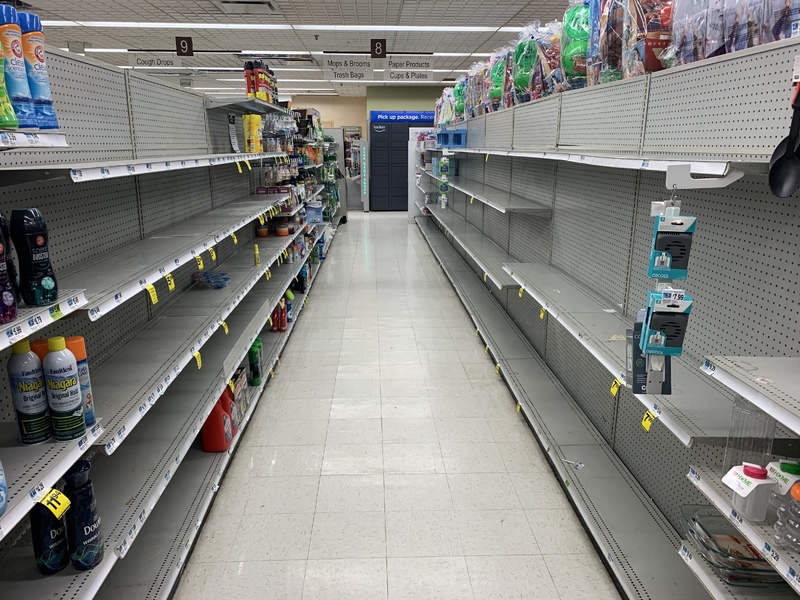 March 2020
March 2020Unprecedented wiped-out store shelves
As I remember now, around mid of March 2020 my undergrad school pushed all students and faculty to an immediate break while college administration had figured out the transforming in-person classes into online ones. Meanwhile, I was thrown into a new reality of Covid19 lockdown in NYC. As a part of it, there were empty shelves in supermarkets and grocery stores. On the first days of the officially declared lockdown, supermarkets became rapidly overcrowded by New York residents who had to rush to buy essential food supplies that could be preserved for a long time. The atmosphere of common panic at the beginning of the pandemic and lockdown seemed to be everywhere in New York. Hence, supermarket shelves naturally turned to be aisles with wiped-out shelves. Besides the essential foods, toilet paper and disinfection items (sanitizers and wipes) also run out with the speed of light. During the lockdown times, I remember challenges in finding these sanitizing wipes and sanitizers in the stores which were extremely needed. I made a joke once in my conversation with a store employee that I would have a time machine to travel to the recent past and buy all needed things and return. Supermarkets’ management decided to limit the sales items to avoid the absolute lack of necessary products in their stores. I could never imagine seeing such a lack of necessary food products in an economically advanced country like the US. In contrast, today and in pre-Covid times I did regularly head to do shopping in supermarkets, and I was able to view fully packed shelves and fridges with all types of various foods and products. -
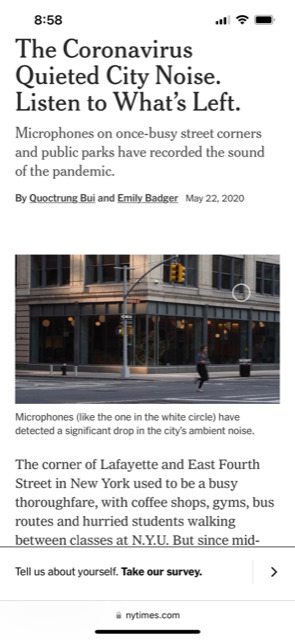 2020-05-01
2020-05-01The Hustle and Bustle That Went Naught
This story is nothing that many of you may not be familiar with, notably of those in metropolitan-like areas. Plus, I can not say that this story is anything deeply descriptive and the likes thereof, but it certainly had an impact on someone like me (along with others) that live in a city, notably if you are especially in or around New York City, the city that never sleeps. What brings me back to this? Well, not exactly the link that I provided that actually shows (at the time of course) a live-time recording of midtown Manhattan and its eerie sound, which is paradoxically a "sound" of a hovering-like quiescent stillness of keen silence (but a silent ambiance that was somewhat peculiarly enchanting) . Or rather, as the title alludes to, a sound that was "naught". At the time, it became so normal if you will (especially around 40 days since the lockdown went into effect), that it became a coincidentia oppositorum of sorts. One might ask, where is such a "unity of opposites" in effect whereby this was simply a "change" in the dynamics of your "said" environment? To start, the Newark (NJ) area is nothing BUT a concoction of familiar and somewhat pleasing noise as I sit in my half-airconditioned room, from the constant sound of public transportation busses passing by and their intrinsic slight familiar screeching stop, the talk of those a few floors down walking the streets, the constant sound(s) of cars flowing by, the sound of the famous pathway train into NYC in the faint distance (though it stops at Jersey City first), those at the corners (as inappropriate as it may sound) calling out that they got "x, y, and z" near Broad and Market Street, so forth and so on, to "almost" nothing! It was like something straight out of the novel Brave New World and other such pally stories of the sort. To me and many others around our surrounding areas, this was a moment in history that stood out, one that I can not recall in similarity since Tuesday, September 11th. 2001. Because the unity of these non-coherent opposites is in the simple fact that the innate aspect of a pandemic lockdown of a such magnitude as we had is quite obviously "silence" if you will, which is the opposite of what is immersed in a city of almost 300,000 (and that is of course not including the amount of citizens in neighboring metro-areas both east, north, and south of my location), nevertheless, they formed one coherent form of a dialectical force. Because it soon became a "norm" and it happened at quite an expedient rate in the larger scheme of things. Nothing was more "quiet" and "surreal" then the tragic events of 9/11, as it did not take some time for a similar situation to occur, as the event was so dynamic that everything I am speaking of happened at once, but and more importantly, day by day the city quickly gained back its ingrained normative environment. But the reason I arbitrarily picked the date of 5/1/2020, rather then use the date of the article, is because it was in early May where this began to slowly engulf me and took me back to one quite sunny day around noon (maybe a tad later), where all of this, "all of this" being that of what I speak of, struck me finally as something transformative (but far less than cathartic to say the least). I hope you enjoyed my little tidbit of what kind of impact COVID had on me (be it a self-like precept, photograph, video, etc...), particular using my experience in a sensory course of description. Sure, there was obviously other aspects that came into play with COVID-19 that eventually impacted us, but most of them were later on as the days moved by, while rather this experience was the first and the one that will stick with me anytime I think back to the pandemic. And the beauty of it, or rather lack thereof, all happened while simply sitting near my bed (hence against the window) while putting on my prosthetic legs. Cheers to you all! -
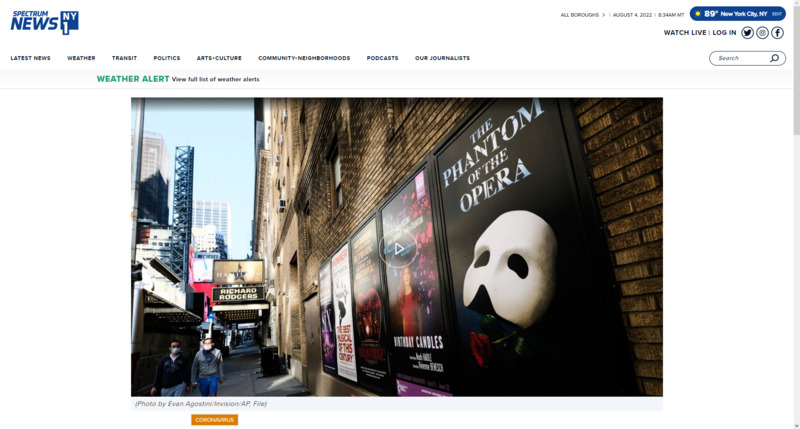 2022-07-05
2022-07-05Broadway begins mask-optional policy
This is a news story from Spectrum News 1 by Louis Finley. On July 1, a mask optional policy began for Broadway show attendees. This has worried theatergoers and performers alike, as they are now anxious over being exposed to COVID. Some shows, like "Into the Woods," have been negotiating to make masks mandatory for the front row. -
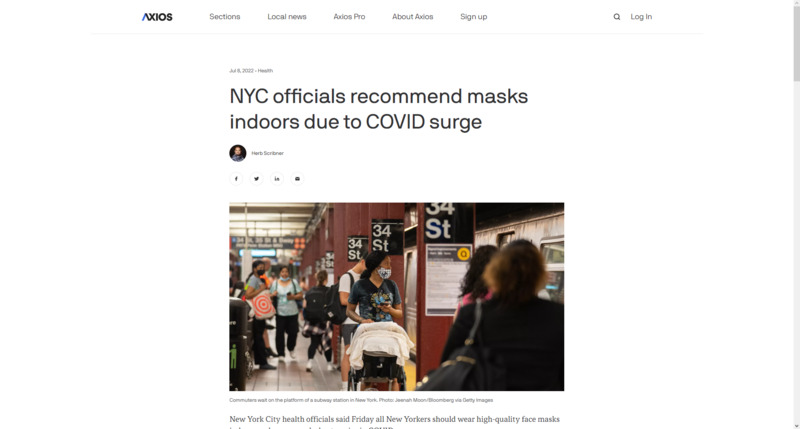 2022-07-08
2022-07-08NYC officials recommend masks indoors due to COVID surge
This is a news story from Axios by Herb Scribner. Due to a rise in COVID cases, health officials in New York City are recommending that people wear high quality face masks indoors or in crowded areas. A CBS News report says that COVID positivity rates have risen 14%, the highest level since January. A subvariant of Omnicron, BA.5, has been responsible for 54% of total COVID cases, according to the CDC. -
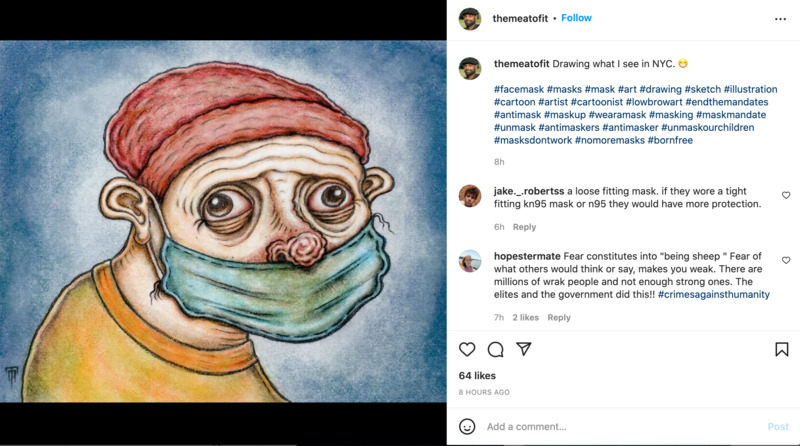 2022-04-22
2022-04-22Drawing What I See in NYC
This is an Instagram post by themeatofit. This is an illustration of someone wearing a mask. The person wearing the mask looks miserable. In the tags the artist uses, he wants the mandates to end. One person, jake._.robertss, suggests that if the person is wearing a properly fitted KN95 or N95 mask that the person will be more protected. -
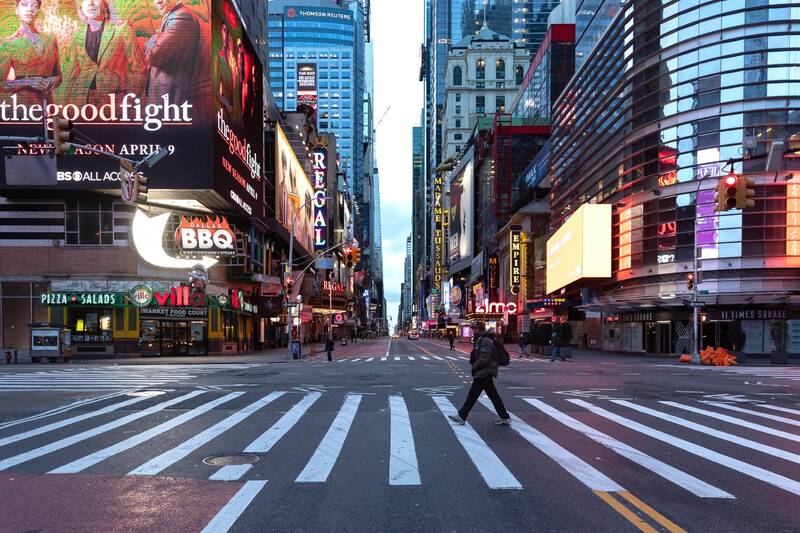 2020-04-12
2020-04-12The Empty Streets of Time Square
“A pedestrian crosses a nearly empty street in Times Square, New York's most-visited tourist attraction, on Wednesday, April 1.” The bright lights and advertisements bordering the streets have no people or tourists to hypnotise and blind. The usual busy streets of New York are almost completely vacant. I personally felt like the world was literally ending. There was no aggressive honking from impatient drivers, no yelling from pointless arguments on the street. Only the sparse pedestrians, the singular car, but nothing else. Everything was closed. -
2020-04
Empty New York
This is a photo I took of an empty street in New York. During the first peek of the pandemic, New York traffic-filled streets and bustling attractions were rather empty. -
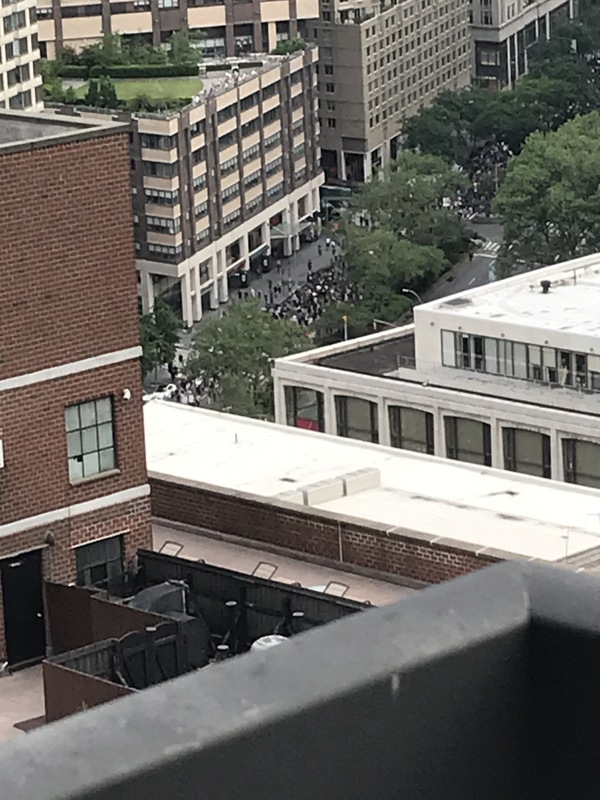 2020-06-03
2020-06-03Protests During COVID
A few months into the quarantining period, protests for the Black Lives Matter movement began all across America in response to the recent unjust violence against African Americans. From my apartment balcony I was able to see the protests in action as they went through my neighborhood, capturing a moment that I thought would be relevant in history for years to come. -
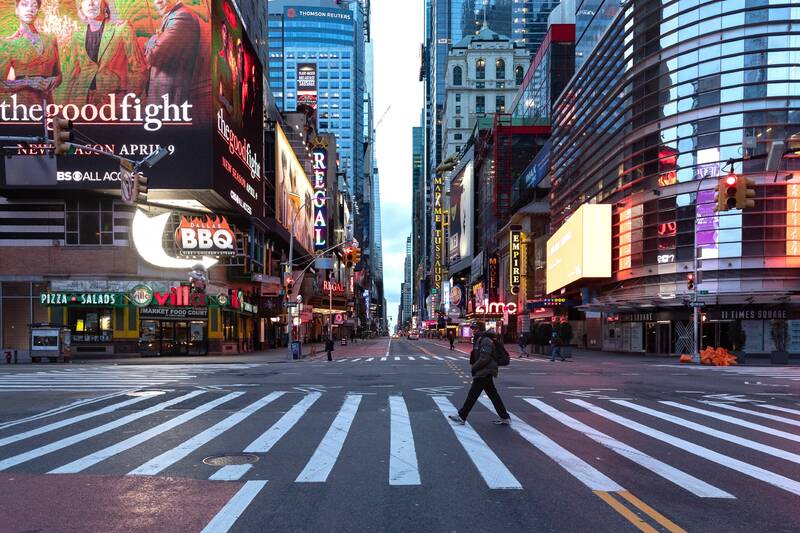 2021-12-16
2021-12-16The Empty Streets of Time Square
“A pedestrian crosses a nearly empty street in Times Square, New York's most-visited tourist attraction, on Wednesday, April 1.” The bright lights and advertisements bordering the streets have no people or tourists to hypnotise and blind. The usual busy streets of New York are almost completely vacant. I personally felt like the world was literally ending. There was no aggressive honking from impatient drivers, no yelling from pointless arguments on the street. Only the sparse pedestrians, the singular car, but nothing else. Everything was closed. -
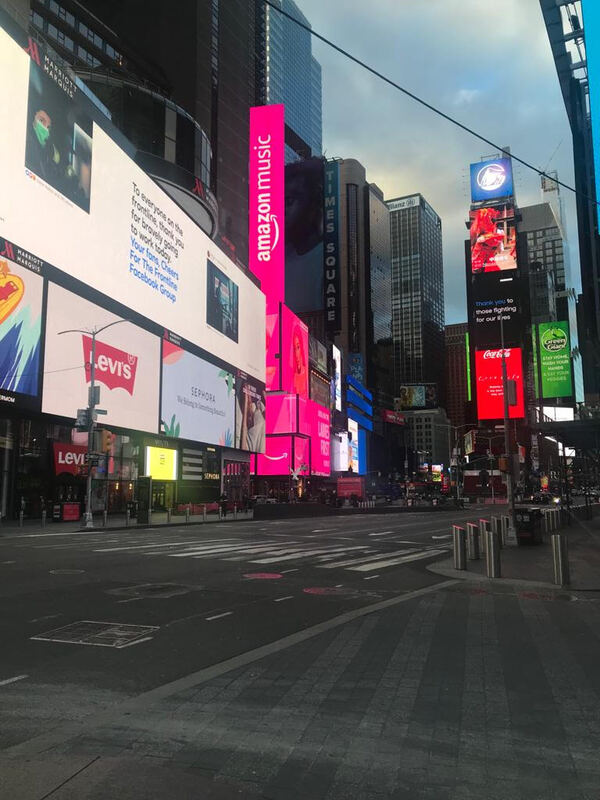 2020-05-04
2020-05-04An Empty Street of Times Square
This photo was taken in Times Square during the early stages of the Covid-19 pandemic. As someone who lives near the always bustling square, it broke my heart to see it so depressing and empty. This pandemic has prompted the question of whether city life will be able to survive Covid-19. Seeing the city so lifeless made me realize how reliant on tourism New York City is. All of the iconic activities that New York is known for, going to restaurants, museums, broadway shows, all had been canceled. However, despite the difficulties, the city maintained a positive attitude, with motivational messages to frontline workers and medical professionals displayed throughout Times Square. -
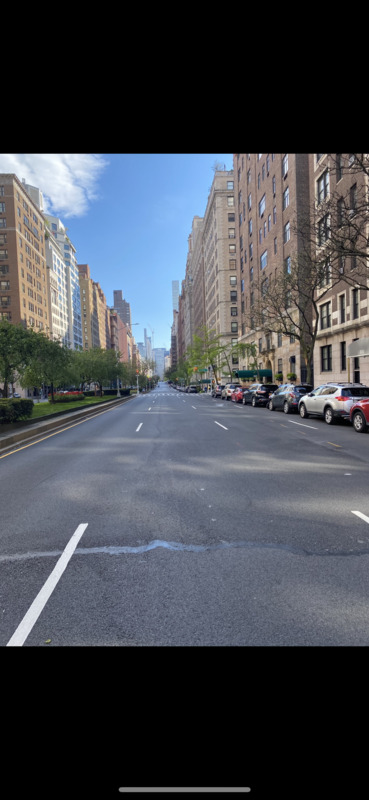 2020-05-02
2020-05-02Empty NYC
The once bustling and lively city of New York, thanks to Covid-19, transformed into a deserted and helpless concrete island. I captured this photo in May of 2020, a depressing time for so many in our city, country, and world. If I had taken an identical photo in the same spot at the same time 3 months before, I would have quite frankly been run over. The concept of one of the most crowded compact cities being abandoned was unthinkable as well as symbolic to the unimaginable and tragic things this pandemic has brought. -
2021-12-16
Cheering NYC
When the pandemic was at its peak, 7pm was when those who lived in New York City would stick their heads out of their apartments, from which they would sit day after day. Together, we clanged pots and pans in celebration of the frontline workers and honored those who survived, or who had been lost to COVID-19. -
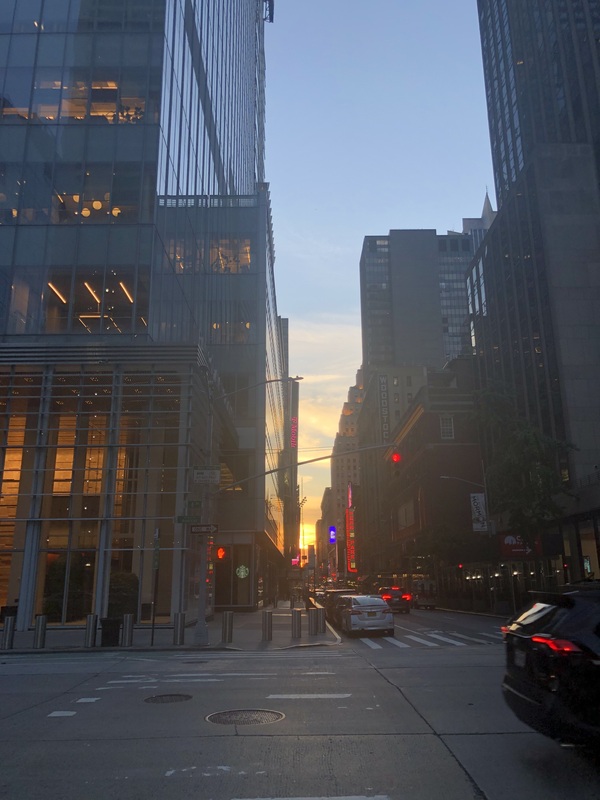 2021-05-31
2021-05-31Empty Dusk of 6th Ave
The streets were different than usual, it was the ironic sense of peacefulness arising from emptiness. -
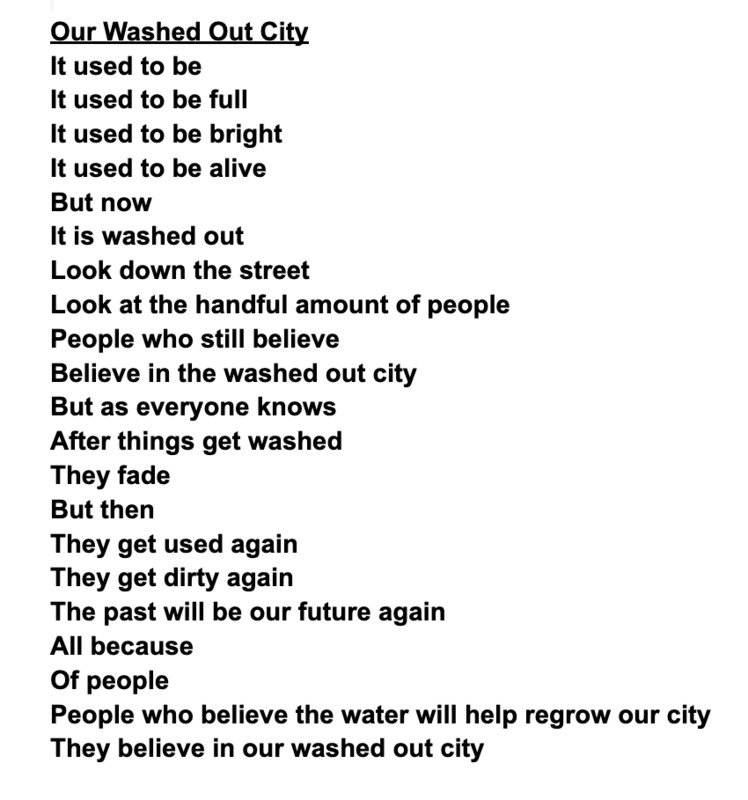 2021-12-16
2021-12-16Our Washed Out City
This is a photo of my poem that I wrote during the beginning of COVID at school. It memorializes NYC and how it was so empty like it was washed out. -
 2020-08-21
2020-08-21Michael Chow Oral History, 2020/08/21
C19OH -
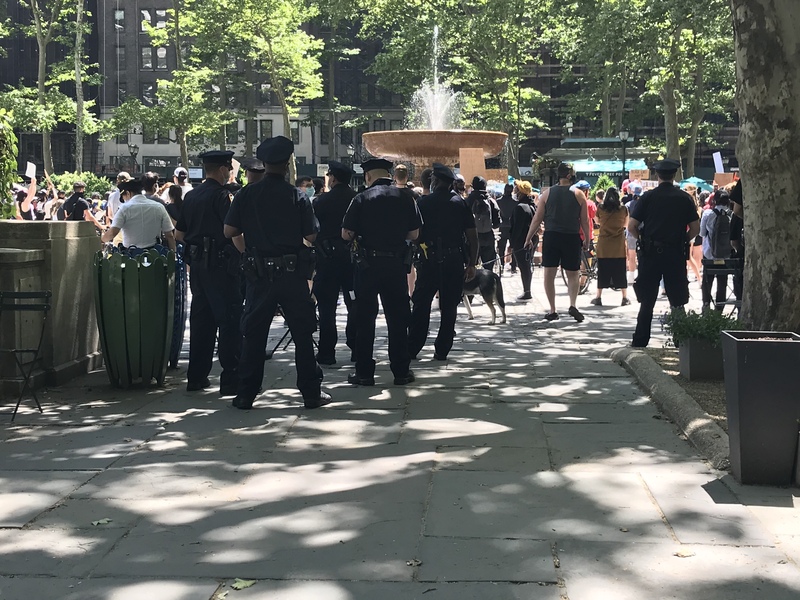 2020-05
2020-05Images from George Floyd Protests and BLM Demonstrations in New York City
Images taken of signs held while listening to speeches from BLM activists. Another image shows a cluster of police during a demonstration in Midtown Manhattan. -
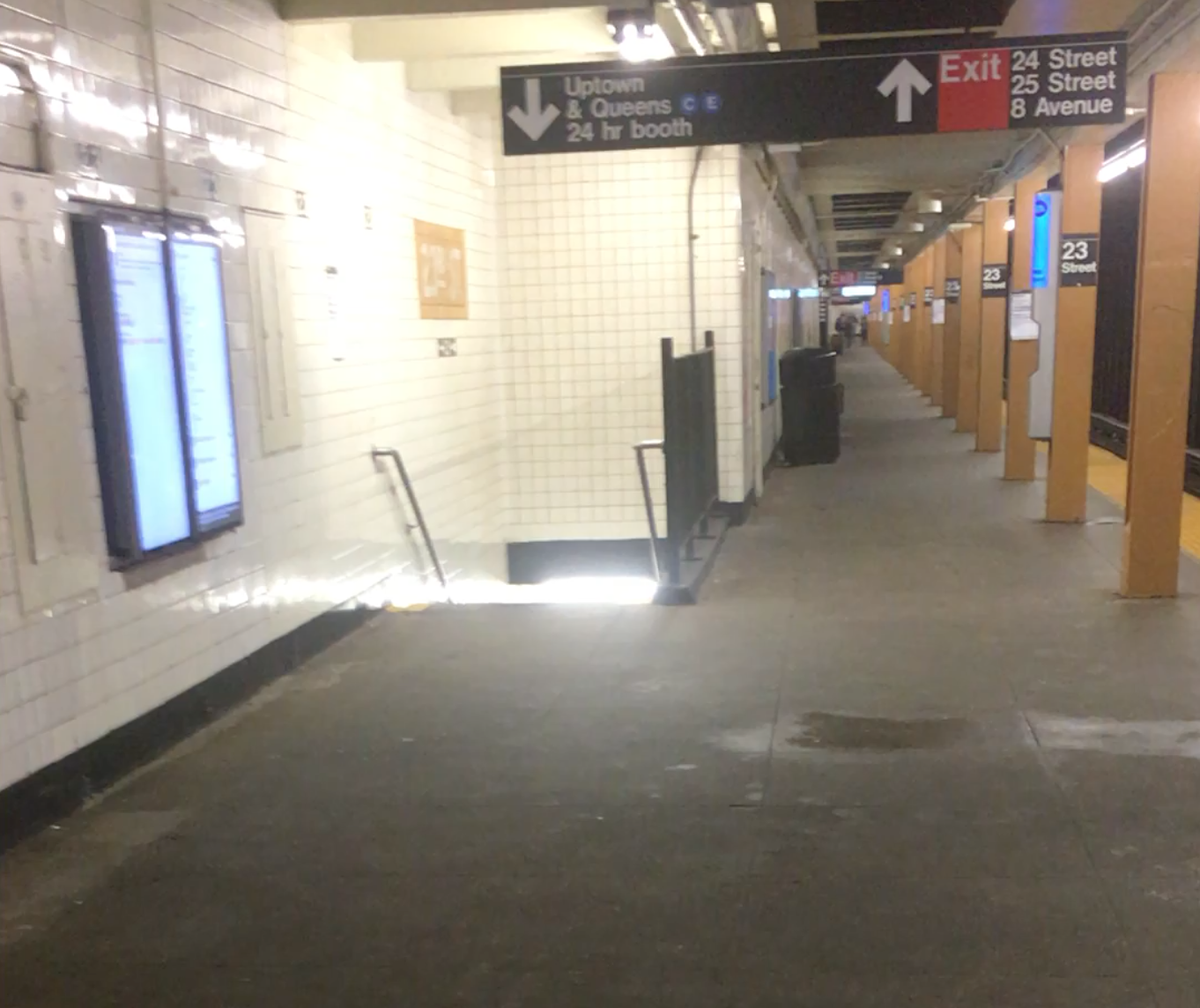 2020-03-13
2020-03-13A, C, E Line 23rd Street
This video was taken on March 13, 2020 on my way home from my last day of in-person work at my gallery where I was employed at the time. I sent this video to my family who lived outside the city and the severity of the situation had not yet hit the town where they lived. Waiting on an empty subway platform after my workplace had shuttered its doors was surreal. I think many of us had a personal experience that we could identify as the moment when we were hit by the realization of how serious the pandemic was (and is). -
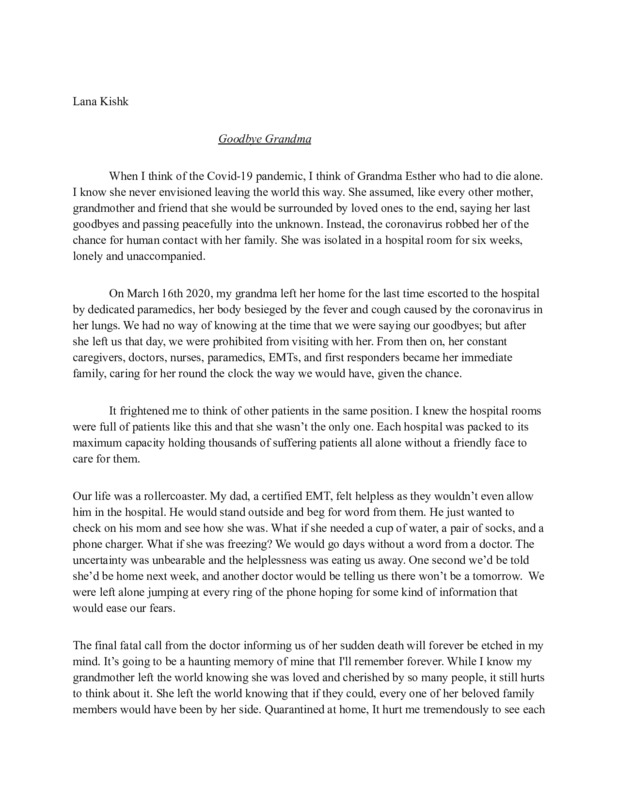 2020-03-10
2020-03-10Goodbye Grandma
This text I wrote is in memory of my grandma, and the horrible and traumatic flashbacks of Covid 19. This experience took a huge toll on me and my family. -
2020-03-15
Corona virus 2020
During the beginning of 2020 everything seemed so fine. I was in school had started a new job at a plumbing company, was occasionally going out with my girlfriend. On top of making money, going to school, i was also hitting a gym and was super happy with my progress in every aspect of my life. All of this was good until, news about how a deadly virus was making its way into the United states from china and how bad it was going to be. Like everyone else i was petrified and i thought there's no way china would let a virus escape they're a powerhouse of a nation. But it did, I remember classes were shut down and shortly after my job was shut down as well, everyone, put in unemployment. During this time my parents had closed on a house and we had become homeowners. During quarantine i remember having to go to our new home and fixing it up everyday monday through sunday so while everyone was at home, doing nothing. My uncles, cousins, father and i were masked up just working in our home. But no matter how far apart we were on different floors and different days, we all got sick. We all also quickly recovered. The covid 19 pandemic didnt have a huge impact on me as much as it did for others. I know a lot of people close to me who lost their loved ones during the pandemic and its truly saddening. My progress with my daily life was lost, school that semester felt like a blur everyone was confused and scared, the gyms were closed, my jobs were closed. I remember hating my life at this moment in time because it felt like i wasn't doing anything but fixing our new family home which i wasn't eager to move in to. Once my jobs lifted in the beginning of june, i quickly picked up my tools and went back into work. -
2020-03
Unimaginable Grief
[March 2020] A month in time no one would ever want to go back to. My friend and I were enjoying our day and suddenly got news that campus will be closed until further notice. It was a scary and confusing moment; before you knew it everyone was talking about the virus. We definitely underestimated the virus and saw it spread in the blink of an eye. Slowly but surely we all began to realize how serious this was and prayed day and night for it to end. Cities went on lockdown, thousands became unemployed, and families grieved the loss of loved ones suddenly taken by this evil virus. I am so fortunate enough to have my close family and friends here with me today, but that does not mean these last one and a half years did not take a toll on me mentally. We've lost many loving family friends whom we never expected to lose this early. One thing the pandemic, thankfully, taught me is to appreciate those who you love because you do not know when they can be taken away from you. As hard as this experience was, I am grateful for the ups and downs and pray for the beautiful souls lost. Rest In Peace <3 -
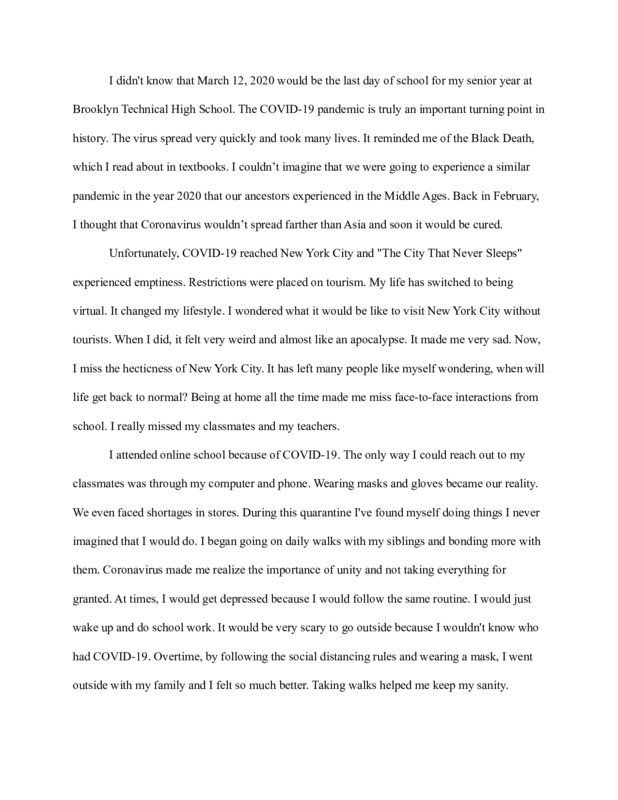 2020-03-12
2020-03-12Living post March 12, 2020
I want to share my feelings and thoughts through text that display what I experienced as a senior in high school during the outbreak of COVID-19. -
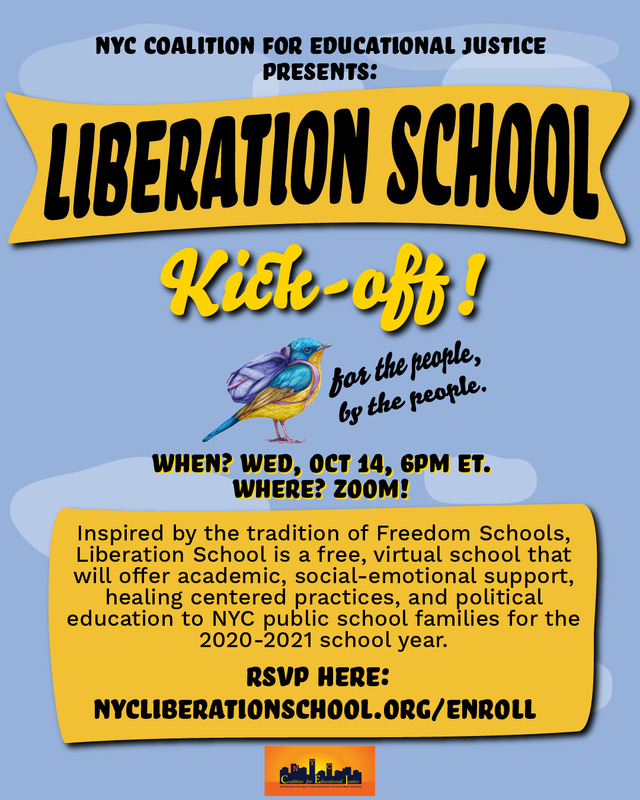 2020-10
2020-10Liberation School: the Mobilization of Back and Brown Parents, Healers and Educators
Liberation School was a free, virtual online school that offered academic support courses, social-emotional support, healing centered practices, and political education courses to NYC public school families throughout the 2020-21 school year. Created by the NYC Coalition for Educational Justice, the city's largest parent organizing group, Liberation school was designed as a response to the failings of the Department of Education to adequately provide the resources and support needed for marginalized students. While many principals, teachers and school staff put their hearts and souls into supporting NYC children during this global pandemic, it was clear that families could not solely rely on City Hall and the Department of Education to deliver a safe, quality education to children finishing out the 2020 school year and going into the 2020-21 school year. Black and brown students and families in New York City have faced the harshest, most devastating impacts of the COVID-19 pandemic and systemic racism. Previous inequities in the school system have revealed themselves and worsened. The Department of Education (DOE) and City Hall did not provide the necessary resources and support for parents and youth navigating remote and blended learning for the first time in a timely fashion or accessible to non-English monolingual families. While many white affluent families were hiring teachers to create learning pods, CEJ designed Liberation School for Black, Brown, Immigrant, and low-income families, who don’t have the financial resources to hire personal teachers or tutors. An important value that shaped the creation of Liberation Schools is the idea of what it truly means to be an ‘inclusive school’. Language Justice is also Educational Justice. CEJ created sessions accessible to the public in multiple languages. Through both multilingual instructors and simultaneous interpretations of English workshops, LS also offered sessions using commonly-used online platforms, outdoor spaces, and live streaming on social media. All courses that were culturally responsive in content and pedagogy and many were conducted in English and Spanish, and some workshops in, Bangla and Mandarin. CEJ was inspired by the tradition of Black Freedom Schools in the 1960s. After Brown v. Board, many schools were still segregated and led to many student movements organizing and fighting for true integration in Northern Cities like Chicago, Boston, and NYC. The first examples of Freedom Schooling were created in the North as an alternative space for students to go to during boycotts in 1963 and 1964. One of most prime examples of Freedom Schooling were the Freedom Schools created by the Student Nonviolent Coordinating Committee (SNCC) in Mississippi. Freedom Schools provided an educational experience for young Black Mississippians to challenge the myths of society, find alternatives to the segregated and racist white supremacists society, to understand the conditions of their oppression, and to create directions for actions in the name of Freedom. There were three general areas for the curriculum of Freedom Schools. One was academic work, which centered around the needs/or interests of the students that incorporated their real life experiences and learning about Black History or understanding the structural institutions. There were also creative activities such as writing, journaling, or arts. The last area was on developing leadership skills and helping students be a part of the change in society. -
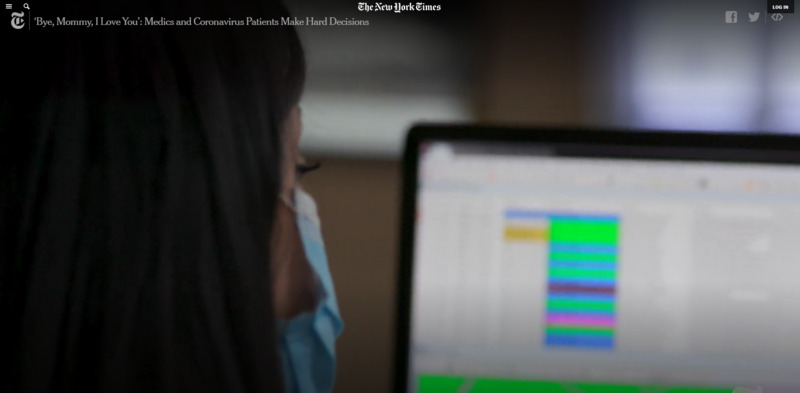 2020-05-01
2020-05-01The start of a pandemic that shock the medical field to its core
I have worked as a NYC paramedic for several years before the pandemic Covid-19 hit the world. As a paramedic, we were trained to deal with most situations that would happen on an emergency basis. We dealt with any situation as simple as a cut on the arm, to as complex as running a mega code on a cardiac arrest patient. When Covid-19 hit NYC, I was unaware of how bad it was going to get. At first, we thought it was a virus that was weaker than influenza, which is something we deal with on a regular basis. At this time, we would get one call a day that was related to Covid-19. I thought that everyone was over exaggerating. Over time, Covid-19 patients became more frequent, and in the matter of a month, it was the only type of call we would get. It was as if every other medical problem that people had went away. But this was because everyone that wasn't infected with Covid-19 was too afraid to go to the hospital. In the month of May 2020, things started to take a turn for the worst. People were starting to get critical on each call, where my partner and I would need to resort to extreme measures like endotracheal Intubation to help them breath. Sometimes, even intubation wouldn’t be enough, and the patient would go into cardiac arrest from the lack of oxygen in the body. It was a very difficult time for me because I felt powerless to stop people from dying to his terrible disease. In June 2020, it got so bad that the hospitals did not have capacity to accept anymore patients that came in. People were put in hallways, next to nursing stations, and hospitals had to dedicate entire floors to Covid-19 patients as they came in. Then another problem started to rear its head. My Co-workers and friends started to get sick. Those of us with families had to also make a choice, either quit their job to protect their families or live apart from them until this was all over. We did not have enough EMT’s and Paramedics to staff the ambulances we had running on any given day. Those of us who were not sick picked up anywhere from 60-90 hours a week. This struggle continues now as well. All over the world, there are not enough emergency services personal to cope with the amount of call volume that we are given each day. Over time we got adjusted to the madness and medicine advanced enough to be able to treat patients so that most did not become critical. Also, the vaccine was made available to the public and things started to get better. I shared my story to show a side of the pandemic most don’t get to experience. It shows how unprepared we were, and how we were able to prevail overtime. I will also include a video to show some insight on the pandemic that was taken with one of the companies I work with. -
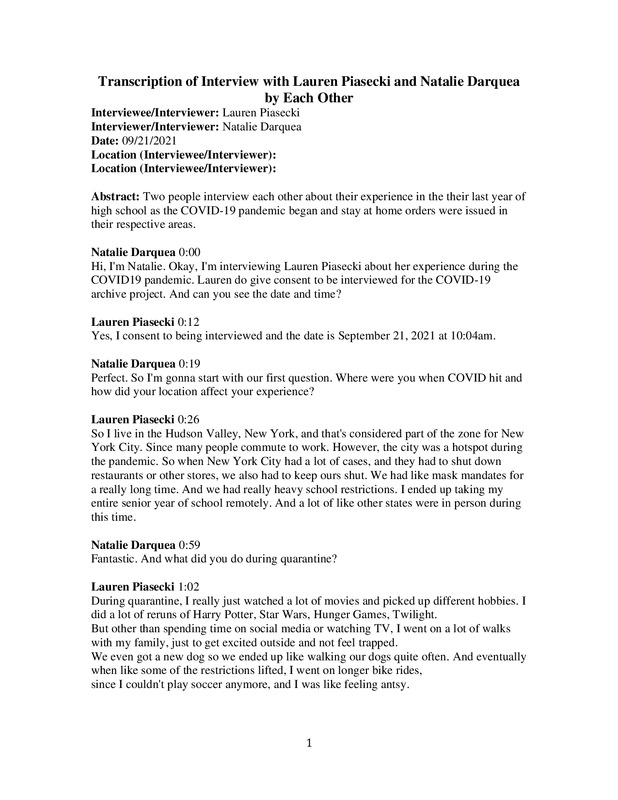 2021-09-21
2021-09-21Lauren Piasecki and Natalie Darquea, Oral History, 2021/09/21
Covid-19 experience at high school students in the US. -
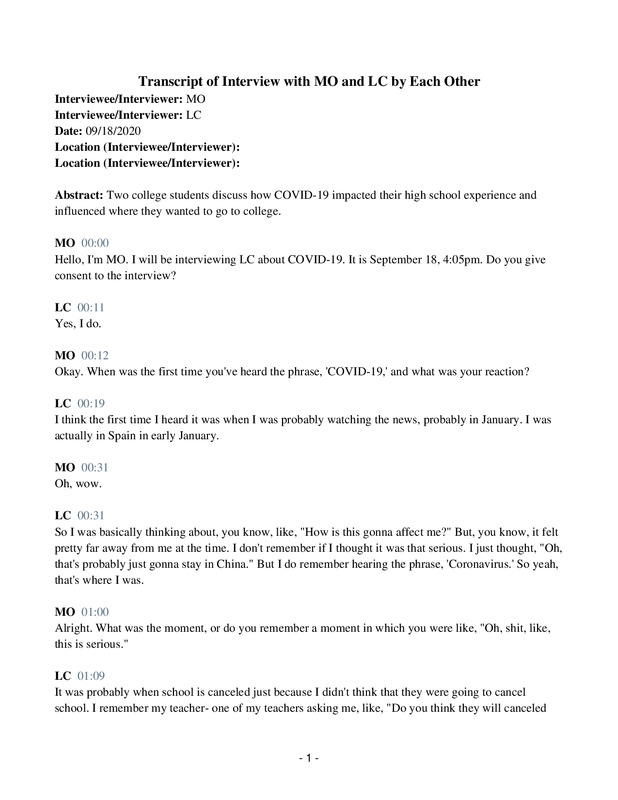 2020-09-18
2020-09-18MO and LC Oral History, 2021/09/18
Basic interviews between two college students looking back on the start of the pandemic. -
 2020-04-06
2020-04-06The City That Slept
When you look at this picture, you notice something right off the bat. Most likely the fact that the streets of New York City are completely empty. On April 6th, 2020, New York City was as quiet as it’s ever been. The streets were empty and there was a ghostly feeling to it. If you were downtown that day, something had to feel wrong. I chose this picture to submit to the archive because these streets represent how the majority of people felt during lockdown; empty and alone. When people are cooped up and confined to the safety of their home, they start to realize the things that they took advantage of when things were normal. This picture also represents the odd nature in which the pandemic brought upon the world. We’ve never experienced anything like this before, and didn’t really have any idea how to prepare. It kind of just happened, and whether we liked it or not our way of life was going to have to change for the time being. While sitting in our homes, time was never an issue and, for me personally, I kind of just expected that one day this was just going to be all over. -
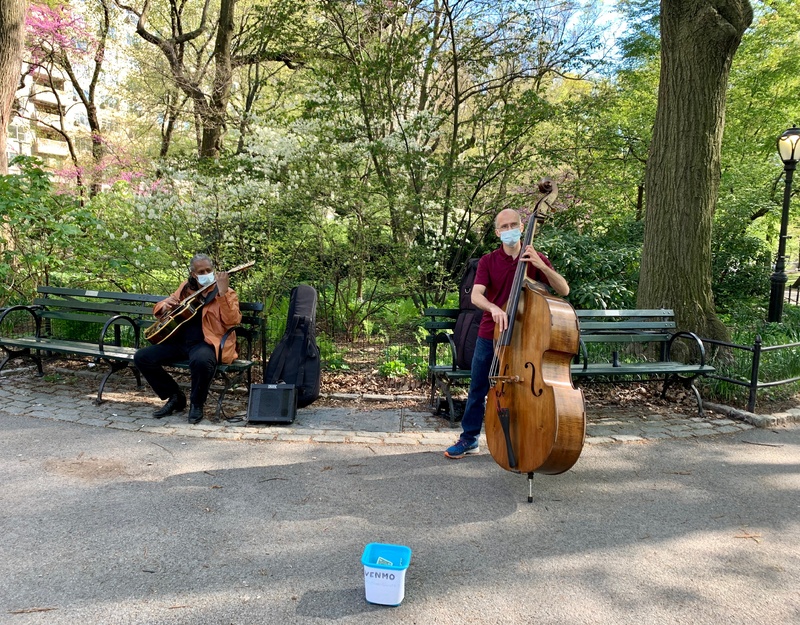 2020-05
2020-05Remembering NYC 2020
These photographs taken from April-June 2020 capture New Yorkers interacting with the empty stress of the city during COVID-19. The first image displays an off duty fireman walking down vacant 5th Avenue, apparently in tribute. His body position highlights the stress, grief, determination, and exhaustion experienced by so many New York frontline workers. The next image was taken of the once bustling streets of SOHO. In this photograph, an older man appears exhilarated during a moment out of quarantine. Getting some fresh air, he turned up his car radio and bellowed out the lyrics of “New York, New York”, the anthem for New Yorkers. The third image captures young cyclists riding, practicing tricks, and laughing. The final snap is of two jazz musicians near the entrance to Central Park, a spot they often inhabited pre-pandemic. They played exactly as they once did, only masked this time. As a twenty year old who would normally be thrilled to spend the summer at home, surrounded by the lively energy of NYC, I was determined to find a way to interact with my city in a creative and safe way. After completing many projects from home (such as making filter masks for medical staff and collecting supplies for donation), I decided to use my knowledge of and passion for photography to capture fellow New Yorkers doing their part to help lower the spread of COVID and to find moments of camaraderie to fuel their, and others’, fight against this virus. In turn, the act of getting in my car and driving throughout the city, equipped with my Canon Rebel 55mm was my way of finding a measure of peace, purpose, joy, and meaning during the six long months in quarantine in New York City. -
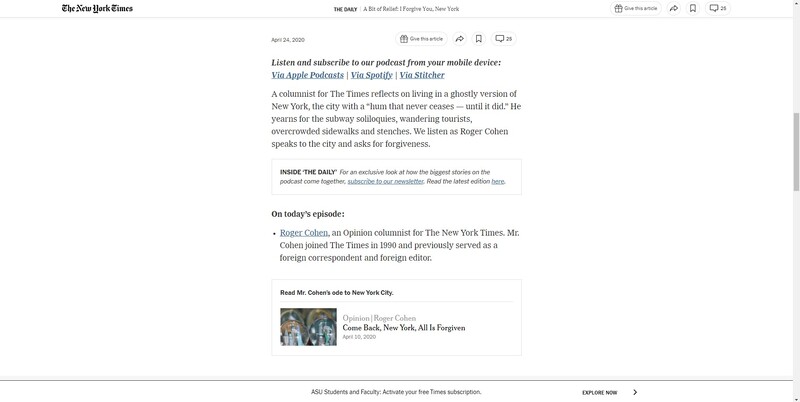 2020-04-24
2020-04-24The Daily, "I Forgive You, New York"
I remember listening to this episode when it first aired during the peak of the pandemic. I am certain I am not alone in the ways this very raw and heartful lamentation of New York City when the city's fate was uncertain. -
2020-03-20
The city does sleep
At the start of the pandemic, I was facing home insecurity and was living in a shelter for three months and special housing for 6 months. The city was the most empty I have ever seen it. Ive seen so many people, homeless people, because of the pandemic and it was devastating. It isolated people. -
2020-05
Waiting to be Connected
I moved out of New York City for a month in the spring of 2020 during the period where my gallery furloughed most employees aside from the principal directors and a select number of sales people. I spent that time with my father in upstate New York in a close quarters quarantine. I was always struck by the quiet during the day and how visible and bright the stars were at night. Two things that seemed foreign to me at times as I grew up in cities and had lived in various Brooklyn neighborhoods for the past year. The passing sound of car stereos and people’s voices on fire escapes from a floor above were white noise. All vibrant - completely alive - no stars. His apartment was a studio and at the time he had not yet begun paying for internet service. Some nights we would drive four or so minutes down the road to the apartment complex where my Dad used to live a few years prior. We would camp outside the complex’s gym which housed one or two treadmills and the outside looked like a glorified garage - but it had wifi. As we were no longer residents and owners of a key pass to the facility, my Dad would pull up to the side entrance and put on his hazards. I would jump out and begin to search for a signal and attempt to connect to the complimentary internet. Whenever a stray person would emerge from their units to retrieve Amazon packages from their front stoop, I would make uncomfortable eye contact with them, as I held up my phone. Yes, yes, this is what you think it is. They hastened back up and quickly closed their door behind them. I found that the most expedient way of downloading content was to position myself by the exterior front left corner and stand with my back flush against the wall. Every night my Dad and I listened to podcasts and drank tea. Despite everything, moments like these helped us laugh and I look back at this memory fondly. -
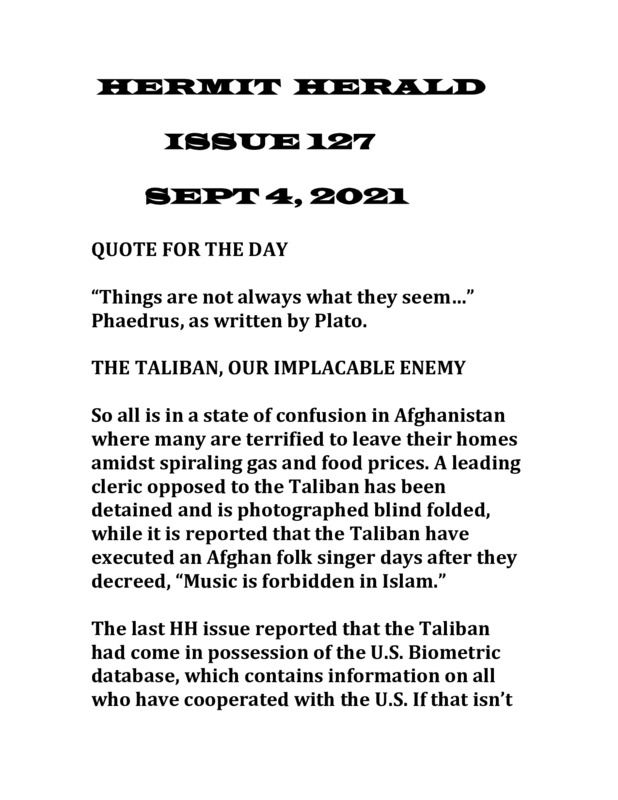 2021-09-04
2021-09-04hermit HERALD, ISSUE 127
Taliban need outside help -
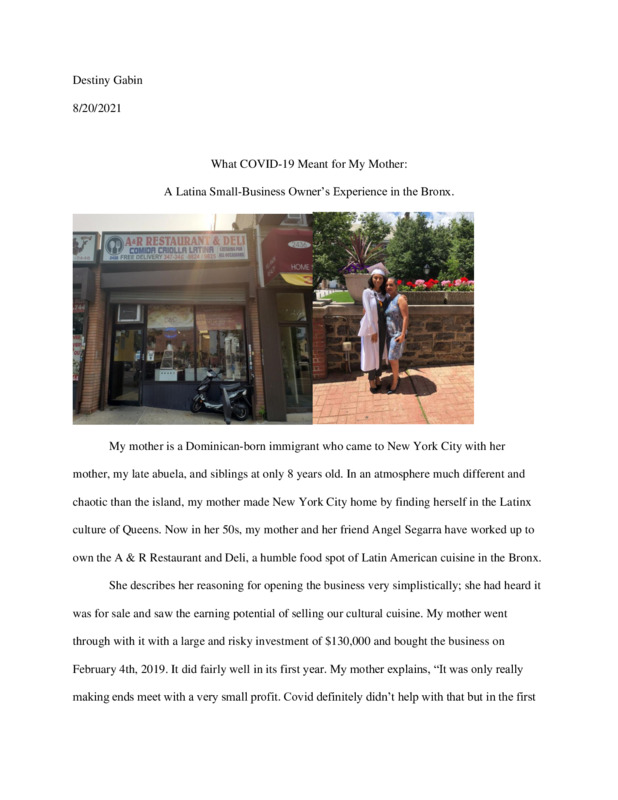 2021-08-22
2021-08-22What COVID-19 Meant for My Mother: A Latina Small-Business Owner’s Experience in the Bronx.
The item I am submitting is a pandemic auto-ethnography detailing the disproportionately negative impact of COVID-19 on Latinx businesses. I do so through the narrative of my own family's experience, specifically my mother, as well as supporting academic research of general demographic trends. This piece speaks to how the pandemic, while in and of itself does not discriminate, has proportions of its impact that demonstrate a systemic bias leaving certain racial and ethnic groups less protected and far more targeted than others. The piece also connects how these discrepancies are not products of the pandemic, but rather were already systemically there and exacerbated by the pandemic. -
 2020-04-07
2020-04-07Bronx Zoo Tiger Is Sick With the Coronavirus
A tiger at the Bronx Zoo has been infected with the coronavirus, in what is believed to be a case of what one official called “human-to-cat transmission.” “There is no evidence that other animals in other areas of the zoo are showing symptoms,” the Agriculture Department said. A pet cat in Belgium recently tested positive for the coronavirus, but the American Veterinary Medical Association said that not enough was known to change the current view that neither cats nor dogs appear to be able to pass the virus to people. The World Organisation for Animal Health says that there is no evidence that cats or dogs spread the disease to humans, but that anyone who is sick should take precautions in contact with their animals as they would with people. -
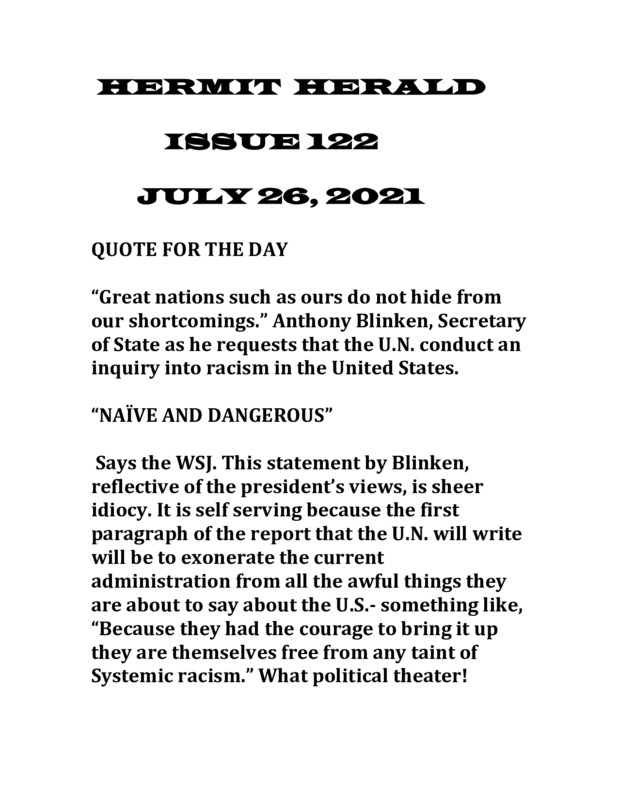 2021-07-26
2021-07-26HERMIT HERALD, ISSUE 122
U.N. asked to critique America -
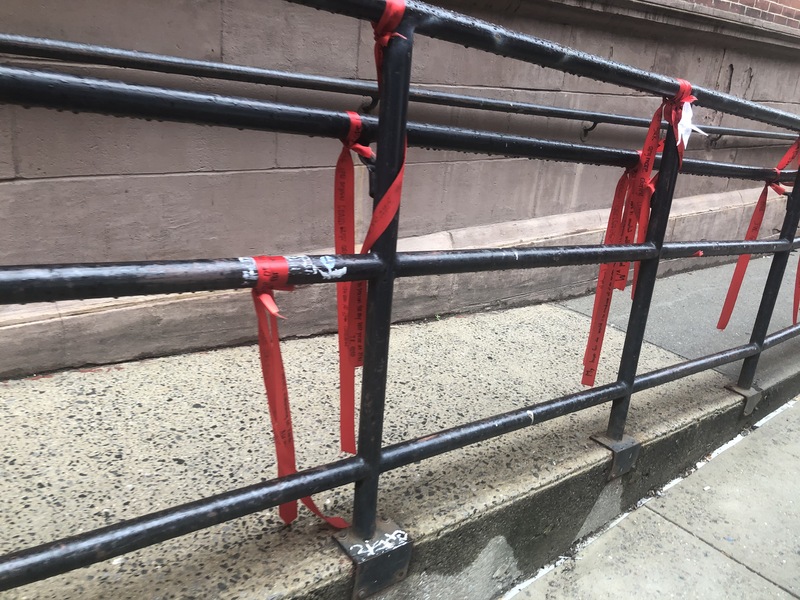 2021-06-13
2021-06-13Red ribbons at P.S. 042 Benjamin Altman
I took these two photos in Downtown Manhattan at Public School 42. There were red ribbons tied around the iron fence that appear to have wishes or hopes from students. Some of the ribbons are hard to read, but one says "[Illegible] make homeless people happy by giving them things I don't need" and another says "My [illegible] that COVID-19 will stop forever". All of the ribbons where the grade level is visible indicate that the ribbons were made by fourth graders. -
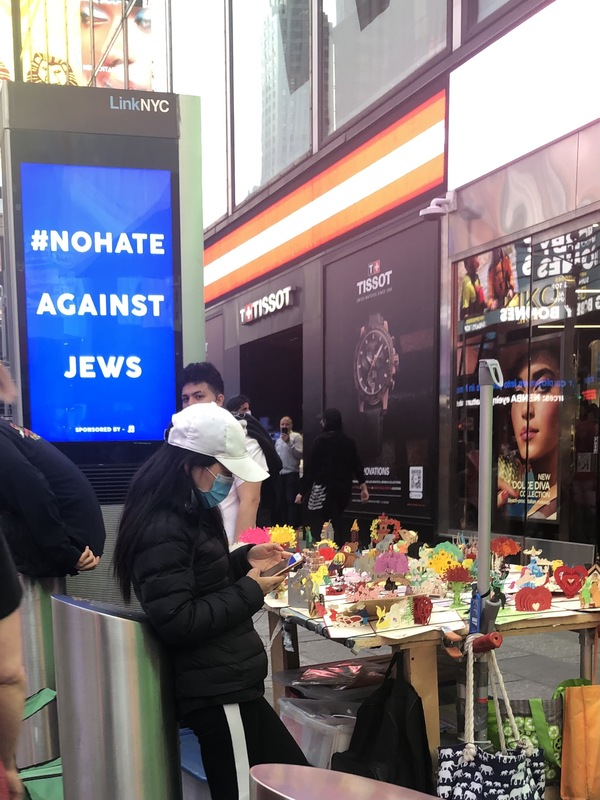 2021-06-14
2021-06-14Anti-racism advertisements at Times Square
These are two photos of anti-racist advertisements I saw in Times Square on June 14, 2021. One is an advertisement on a digital advertisement board that says "#NOHATE AGAINST JEWS" in white text on a blue background, while the other is a poster on the side of a garbage receptacle that says "FIGHT THE VIRUS NOT THE PEOPLE #STOPASIANHATE", made by artist Zipeng Zhu. -
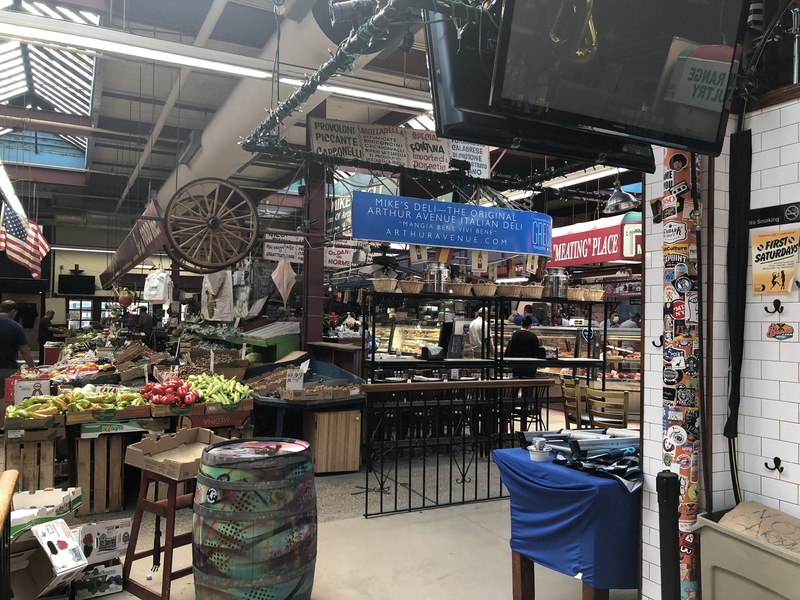 2021-06-18
2021-06-18A Linguistic Tour through Arthur Avenue
I traveled to New York this summer, and one of the places I visited was Arthur Avenue, located in the Belmont neighborhood of the Bronx and the main artery of the Bronx's Little Italy. Arthur Avenue provided a unique insight into the function of immigrant languages during the pandemic. Most of the people I heard talking as I walked down Arthur Avenue and went into the stores were speaking English, as would be expected in most of the United States. Some had an accent similar to a "standard" American accent/my Californian accent, while others spoke in New Yorker accents. I heard some people speaking Italian, mostly if not entirely elderly people, in several stores, including Cerini Coffee and Gifts. I also heard expression of language through music, in the form of a speaker in front of Mario's Restaurant playing "Tu vuò fà l'Americano" ("You Want to Be an American") and "O Sarracino" ("The Saracen"), two famous Neapolitan language songs. I didn't expect to hear music in Italian "dialect" (called so even though Neapolitan is a proper stand-alone language). However, Belmont is no longer just Little Italy. It also has a large Albanian presence. I saw a flyer on a street pole in Albanian which I presume to either be a missing sign or a flyer for a funeral. I have no idea what the flyer said because I don't know Albanian, but among the text were two pictures of an elderly man. In front of Randazzo's Seafood, I also saw a sign advertising some type of shellfish (I can't remember which) in Albanian and English, though not in Italian, which I thought was interesting since the store is owned by the grandchildren of immigrants from Sicily. There was also an Albanian television provider called TV ALB, which indicated to me that there are enough Albanian speakers in the area to sustain an Albanian-language cable or broadcast provider, even during the pandemic. I didn't hear any spoken Albanian. This could be a purely anecdotal observation, but I saw Italian primarily as a spoken language and Albanian primarily in writing. There was some writing in Italian, but most of it was either names of food items that couldn't be translated into English or sayings like "mangia bene vivi bene" ("eat well, live well", as a command; the picture of which is attached to this story) for promotional purposes. There was no actual communication occurring in written Italian. On a non-linguistic note, most of the restaurants also had outdoor seating under canopies, a consequence of COVID. -
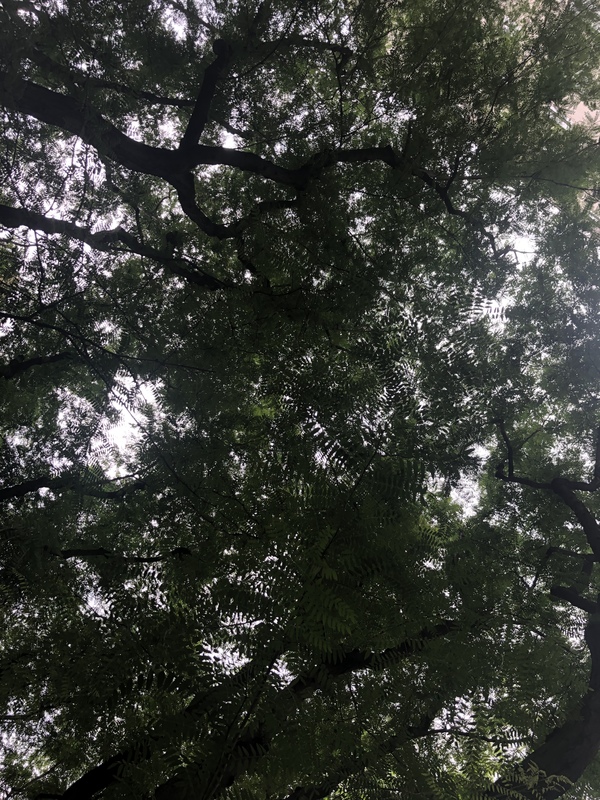 2021-06-18T17:20
2021-06-18T17:20Greenacre Park
When I visited New York, one of the places I went to was Greenacre Park in Manhattan. The small, house-sized park is a wonderful example of nature in the middle of a mass of high-rises, with a wall of ivy, a waterfall, and many trees. There were about 15 people there, all doing various things. A man was working on his computer, as can be seen in one of the photos. Quite a few people were on their phones. Meanwhile, a group of tourists took a selfie photo, and a pair of elderly women shared a carton of fruit nectar. Underneath a canopy, others sat and read or worked. It was nice to see people still enjoying nature as the pandemic finally winds to a close. I also thought it was interesting how many people were using technology (including me!) in a natural space apparently meant to provide a break from the rush of normal life. -
 2020-03-15
2020-03-15Daycares empty during the Pandemic
For my primary source I selected a picture of a daycare. This daycare is where my kids used to go. Before the pandemic started, I used to take them there because I have to go to work. One of them was 7 months old and the other one was 5 years old. I used to take them to the daycare six days a week except Sunday, then go to work and when I finish working, pick them up in the daycare around 5pm. I selected this source because I want Historians of the future to know how the pandemic hit ‘’daycares’’. This photograph was before the pandemic. I took it in the daycare in a birthday party that we did for my son. There is the babysitter, her assistant and other kids that used to go to the day care. I feel Historians will learn how difficult was the life for mothers who have to go to work and leave their kids in daycare and what happened to me when the day care was closed. Everything was normal until I heard about COVID 19.I have been working in a hospital and in march 15 2020 my Babysitter told me that in 3 days the daycare was going to close for undefined time because of the covid 19.I was scared to go to work because I did not want that nothing happened to my kids. I had to go to work in the hospital, but I did not want to because I know that I was going to be more exposed to the virus and I may bring it to my kids. But the other reason was that I don’t have nobody to take care of my kids after they close the daycare. In addition, my Babysitter also told me that she was desperate because she was not making money in the daycare. I decided to stay at home with my kids. I remember that the school also was closed. But I was not getting pay when I stay at home. It was a very difficult time for me because I had bills to pay, including the rent. I was feeling bad because I have some savings, but 2 months after march I realized that I did not have money to pay the rent. I realized that I need to go back to work, even thought I was thinking that I was going to be on risk to get the COVID, I found somebody to watch my kids and then I went back to work. I pray God for protection every day, in the bus, streets and the train. In august the daycare opened again, the Babysitter was happy because she was going to work again, but I was scared because I did not know if anybody in the day care could be sick and get my kids sick. I have to take my kids to the daycare, but it was not like before that Babysitter had many kids in the daycare, only my two kids were in the daycare. Today, my son is back to school and the other one is still going to the day care, but every day I pray for theme because I know that other kids are with them, and I don’t know who may be sick and they are always on risk, but I don’t have other choice because I need to work to get money to pay my bills as I say before. When I arrived home, I leave my shoes on the front door, go straight to wash my hands, take clothes of, take a shower and them pick them up in the daycare. Every day my kids are on risk, but I am also on risk at work. The situation is difficult, but we have to continue our lives, be wise and do our best to keep our family safe all times. -
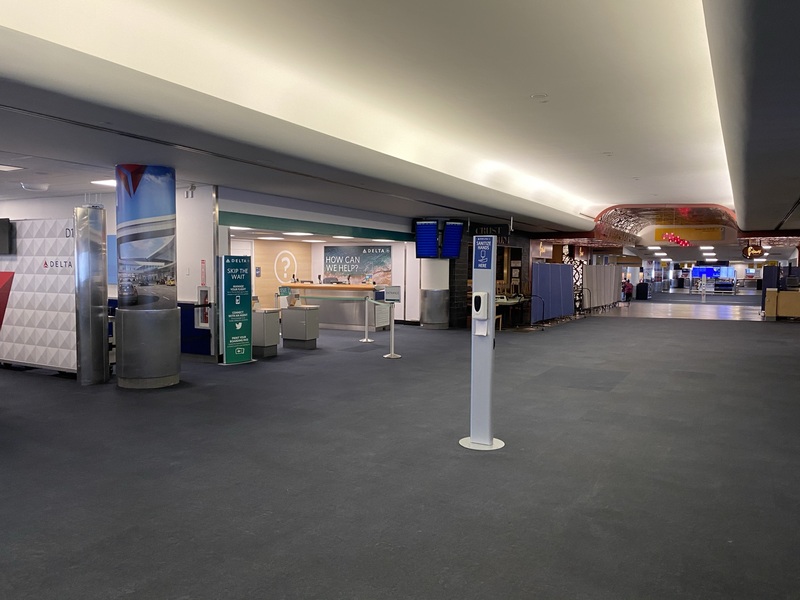 2020-05-20
2020-05-20LaGuardia’s Ghost Town
For my primary source, I selected a photograph I took of the gate house area in LaGuardia Airport in mid March of 2020. In the picture it shows several employees, sitting around doing nothing at all, the whole airport was a “ghost town”, meaning there were no passengers to assist with there tickets and gate claims, or any questions in general. During this time we were all nervous, not just nervous about COVID-19 and from the horrific scenes in the news, but also as an 11 year veteran in the airline industry, our jobs were on the line because of the decrease in flying, fear of flying, and the travel restrictions of no flying. With the airline burning 35 million dollars a day how can they pay 80,000 employees system wide I told myself. The airline soon told us system wide that it’s recommended we take a leave of absence at least a year with no pay to save the company or else there would be cuts, not including the 25% cut in our salary we took already. All week I was on the phone with my work partner talking everyday trying to figure what’s the plan. All these thoughts came racing three my head. What are we going to do? Do you think we will be fired or let go since we have seniority? Why I didn’t finish college 13 years ago and became lawyer or something. My job made us an offer, hey said take the year off with no pay, and your still have flying benefits for you and your family as always, and you will still have full medical benefits and we will pay your medical as well. After talking with my family, my fiancé, my partner from work, I decided on March 26th 2020, I was going to take the leave of absence. A whole year later April 26th of 2021 I finally came back to work full time, and the airport passenger count is starting to increase. The reason why I seated this primary source is because I would like historians to know the insides that us airline employees faced during these challenging times. I know many airline companies asked Congress for help in payroll support for the employees which majority of them did get including us, but we never saw that payroll support, nor did they call us back Early to work since they got some kind of support from the government, instead that money went in the stock market, and for bonuses to the CEO, and managers in the company. While I am happy and very fortunate to be back at work, it was very challenging as I’m sure it was for everyone, but one good thing that came out of it, 13 years later, a year ago from today. I was able to join the family of bronx community college, and focus on my education while I was off. -
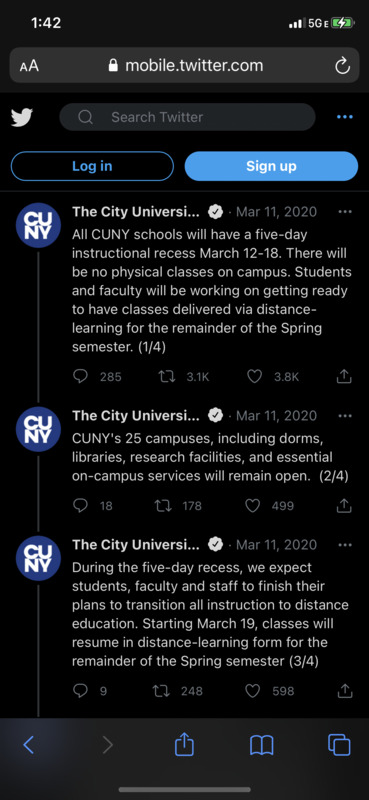 2020-03-11
2020-03-11CUNY's Response
Where to even start? 2020, the year where everything and everyone changed forever. 2020 did not just consist of the Covid Virus it consisted of many other threads that harmed everyone’s mental health including students. It was hard for all students during this time but in my perspective College students. This documents faithfully explain 2020 and I will be here to give you future historians a more in depth look at how it really was during these times. The document I chose not only explains how we went from going in person to virtual but also how it made me feel as a visual learner and as a college student of course. CUNY mentioned we were going to have a “Instructional recess from March 12-18th”, this day I will never forget because I did not know that March 11th was going to be the last day of my two-years of college. When I received this email on Twitter that CUNY had stated this I was overwhelmed and shocked. The thought of everything being virtual just didn’t seem right to me, although I did have all the access from computers to internet access, it just did not sit right. As a visual learner this was tough for me, this was a moment of you get classwork and you basically have to teach it to yourself, not seeing my professors in person and through a screen was very hard to get used to, the internet sometimes would not work and it would cut off and I would miss most of the important things said during the lesson, it was honestly very difficult, this was not just tough on students, as well as professors having the same issues. This era was honestly tough, but technology really saved a whole year worth of schoolwork. To the historians reading this in a couple of years from now, I, as a person who lived through these times want you to understand the rough time we went through, from masks to face shields to many deaths and virtually going to school. These were moments in time that no one anticipated. It shaped the future into what it had become, masks may become the new norm, working from home may be allowed for certain jobs and companies, schools just might let people continue to be fully virtual and things may be extremely dependent on technology from now on. To conclude this 2020 document, though it was a rough year where millions of people died worldwide, I can only be thankful that me and the ones I love are safe and okay. We now know how to take proper precautions in case anything like this happens again, though I don’t wish for a repeat of 2020. The year of 2020 is one for the books and one that will go down in history.
